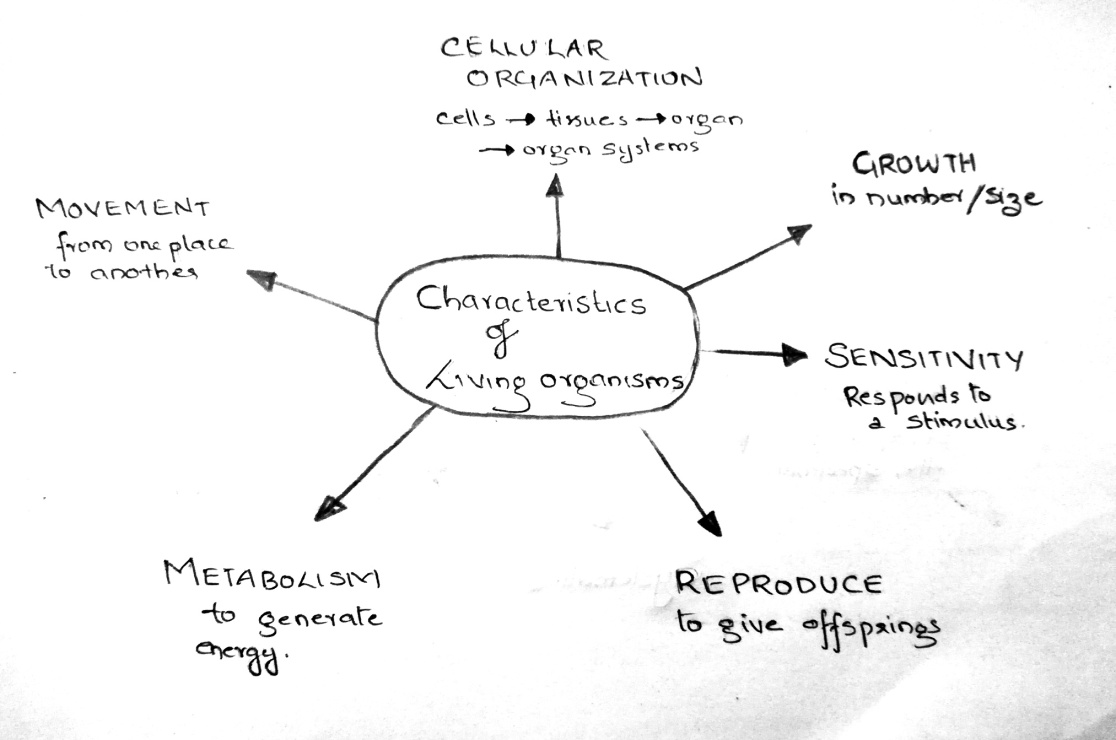- Living Organisms
How do we define “life”? To decide whether a given thing is alive, we will look for the presence of certain features that are generally found in all living organisms. Life refers to these qualities of living organisms that distinguishes them from the non living.
Fundamental properties of life

Cellular Organization: All living organisms are made up of one or more cells. Each cell, in turn has a complex organization of molecules within it. Accordingly, living organisms are classified as unicellular and multicellular organisms. In unicellular organisms, the single cell performs all the life sustaining activities of the organisms. In multicellular organisms, different groups of cells (tissues) are organized to carry out every vital body functions. This property of cellular organization is a unique property of living organisms.
Growth: All living organisms will grow. Growth refers either to the increase in mass or increase in the number of individuals. In multicellular organisms like plants, animals, algae etc. growth occurs by increase in mass of the organism due to internal cell division. Unicellular organisms grow by increasing the number of individuals by cell division. However non-living things can also grow by the accumulation of materials on their surface. For example, sand dunes in deserts can grow bigger if more sand is deposited on it by wind. Hence, the ability to grow is not an exclusive feature of living organisms.
Movement: Living organisms can move around. But it is not a diagnostic feature because plants and some animals cannot move. Moreover, non-living things like clouds, air, water in river etc. can also move from one place to another. Movement is just a property possessed by some living organisms.
Sensitivity: All living organism posses the ability to respond to a stimuli. Growth of plants towards light is a typical example. Organisms use their sense organs to detect any environmental stimulus in the form of physical, chemical or biological cues. This feature of organisms being ‘aware’ of the surroundings is known as ‘consciousness’. However, not all stimuli can evoke a response. Imagine beating a tree with a stick. There will be no response from the tree. It does not mean that the tree is lifeless. However, try doing the same on your friend. You are definitely going to get a response.
Reproduction: All living things will die eventually. Hence to ensure the continuity of life, living organisms reproduce, either by sexual or by asexual methods. Multicellular organisms reproduce sexually, creating a progeny which is genetically different from the parents. Unicellular organisms mostly use asexual reproduction methods.
Unicellular fungi like yeast reproduce by budding, while multicellular fungi also multiply asexually by means of spore formation. Planaria undergoes regeneration to give rise to new individuals. All other unicellular organisms (including bacteria, Amoeba, algae etc.) multiply by binary fission to produce new daughter cells. Their reproduction is synonymous with growth. Non living things will never reproduce. Hence, reproduction is a defining feature of living organisms.
However, certain animals like mules, sterile worker bees and infertile human beings cannot reproduce. Therefore, reproduction is not an all-inclusive (necessary) feature.
Metabolism & Regulation: Each cell is composed of different types of biomolecules such as carbohydrates, fatty acids, proteins, which are constantly being made and then broken down to form other molecules. These chemical reactions maintain the living state of cells in an organism, and are collectively known as metabolic reactions. The sum total of these reactions is called metabolism. It can be catabolism (breaking down of molecules) or anabolism (synthesis of biomolecules). Organisms also have well maintained regulatory mechanisms to regulate these reactions. Non- living things do not exhibit metabolism. Therefore, cellular organization and metabolism are defining features of living organisms.
To a large extend, possessing all these above mentioned qualities define what we call ‘life’ or ‘the living’.